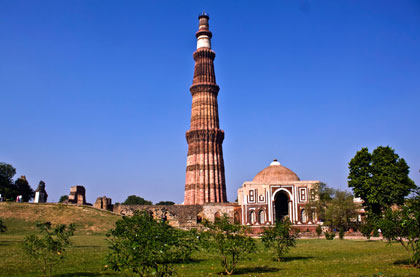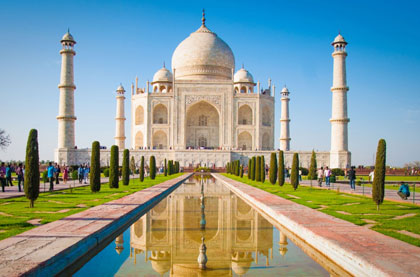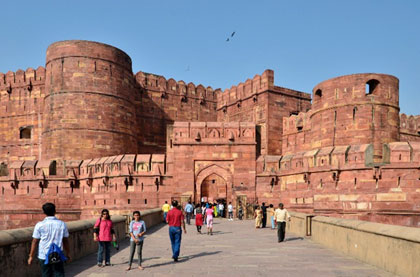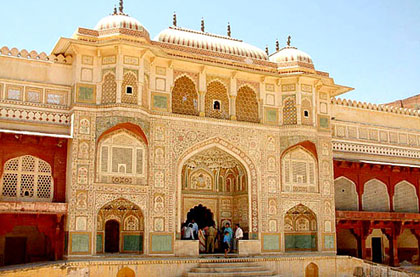Agra Tour Travel
Agra - the city of Taj Mahal - is widely recognised as one of the most artistically inspiring cities globally. What makes this city a culturally rich destination is a total of three UNESCO World Heritage sites: the Taj Mahal, the Agra Fort and Fatehpur Sikri. Thousands of domestic as well as foreign tourists flock to this city annually to view these wonders along with the other plentiful attractions present here. Along with Delhi and Jaipur, Agra is a part of the Golden Triangle tourist circuit.
The city, situated on the banks of the River Yamuna in the north Indian state of Uttar Pradesh, was chosen by Mughal Emperor Akbar as his capital. Today, it is a beautiful amalgamation of the culture and traditions of the bygone Mughal era and modernity represented through various industries, shopping malls, plazas and high-rise buildings.
The city with its historically rich past, abundantly clear from the many splendid monuments from the erstwhile past in and around the city, is a tourist’s delight. We find the earliest mention about Agra from the Mahabharata where it is referred as Agrevana meaning ‘the border of the forest’. And sources prior to the Mahabharata refer to Agra as Arya Griha or the abode of the Aryans. Agra was referred by its modern name for the first time by Ptolemy, the famous Greek astronomer and geographer.
Agra Top Palaces :-
Taj Mahal
The most famous of the monuments of Agra, India is the Taj Mahal. Taj Mahal is a symbol of the devotion and dedication of love. Taj Mahal of Agra is a monument built by emperor Shah Jahan In the memory of her wife Mumtaz Mahal. Taj Mahal expresses the magnificence of Mughal architecture. The Taj has done wonders to Agra Tourism. Taj is a must in each one of the Agra packages offered by us. Agra to Jaipur is an interesting package option.
The very first thing every tourist who comes to Agra wants to do is see the beauty that is Taj Mahal. No matter how many times you’ve been here, it will leave you mesmerized with its intricate carvings and architecture. The Taj Mahal is certainly the main attraction that draws millions of tourists to Agra every year and rightly so. Called the epitome of love, it was constructed by Shah Jahan for his beloved wife Mumtaz Mahal whose tomb rests right under the central dome of the monument. It took 22 years and over 20,000 workers to construct this marvel. Shah Jahan spent his last years imprisoned in the Agra Fort gazing at his creation and after his death, his tomb was placed inside the Taj Mahal next to his wife. The white marble monument is an architectural marvel with fine detailing, on the south bank of the Yamuna River. Verses from the Holy Quran are inscribed on it, gemstones adorn its walls and the intricate inlay work adds a touch of magnificence to the structure. Another brilliant fact that makes it a masterpiece is its symmetry, which is why it looks the same from all four sides.
Agra Fort
Another architectural jewel in this city is the Agra Fort, a UNESCO World Heritage Site. It was built by Mughal Emperor Akbar with the help of 4,000 workers who worked for eight years to finish its construction in 1573. Agra Fort is made of red sandstone and was the seat of the Mughal Empire. Some of the major attractions in Agra Fort that will leave you mesmerized are structures like the Sheesh Mahal, Moti Mahal, Jehangir’s Palace and Khas Mahal. The fort has four large gate of which the Delhi Gate was used for the king’s formal entry. Diwan-i-Khas and Diwan-i-Aam were reserved for royal audience and the public respectively.
Agra Fort has been prominent during the Mughal reign. Even though Akbar built it, during the rule of Shah Jahan, he renovated it by adding marble work and converting the raw red sandstone structure to a palace. Years later, his son Aurangzeb imprisoned him in the same fort at Mussaman Burj. Do pay a visit to this part of the fort as it offers one of the best views of the Taj Mahal. Despite these changes, Agra Fort is an epitome of Mughal architecture at its best and shouldn’t be missed.
Fatehpur Sikri
One of Emperor Akbar’s pet projects was building a walled city a little away from Agra. He called it Fatehpur Sikri and even ruled here for sometime before he was forced to move out due to shortage of water supply. Nevertheless, the surviving monuments tell a tale of his valour and great work. Fateh in Persian signifies victory. The city survived and three of its walled sides are still intact. Akbar paid keen interest in its architecture and layout and it took about 15 years to plan and build it completely. Once ready, it had palaces, harems, buildings, courts and a mosque. But one of the best architectural wonders of Fatehpur Sikri is the Buland Darwaza, a grand gateway to the walled city. Made of red sandstone, there are 52 steps that lead up to its 175 ft high archway that has two inscriptions. Akbar’s favorite minister Birbal too has a monument in Fatehpur Sikri called Birbal’s house. Since he was a Hindu, the architecture is different than the usual Mughal buildings.
Akbar’s Tomb
Akbar the Great built some majestic monuments in his lifetime and one of them was his tomb itself. The task of commissioning your own tomb is part of Turkic custom that Mughals adhered to. He even selected the site where he wanted to be kept. His last resting place, Sikandra is where Akbar’s Tomb is. His son Jehangir completed the construction of his father’s tomb in 1613 and it was beautifully carved, made of red sandstone. Just 1 km away from Akbar’s Tomb is Mariam’s Tomb, who was Akbar’s wife and Jehangir’s mother. The monument is open for visitors on all days of the week from 6 am to 6 pm. The entry fee for Indians is Rs 15 and for foreigners it is Rs 110.
Mehtab Bagh
Mehtab Bagh is the perfect spot for admiring the beauty of the Taj Mahal. Built by Babur, it is a square garden that was once resplendent with pools, fountains and trees. Today, it makes for a recreational tourist spot. A Mughal garden, it is perfectly aligned with the Taj Mahal along the Yamuna River and was described by Shah Jahan as the ideal spot for viewing the Taj Mahal.
Due to frequent floods and extraction of building material by the villagers, the garden lay in ruins by the ‘90s. However, the Archaeological Survey of India (ASI) intervened and started work to restore the garden to its original state. They even made sure that the plants used in Mehtab Bagh were ones that were originally a part of Mughal gardens. These included guava, Ashoka, jamun, neem, hibiscus, etc. There were four sandstone towers too in the garden at its four corners, however, only one remains now. During the restoration, other structures were added to Mehtab Bagh that were not originally a part of it. Some of these include a statue of BR Ambedkar holding the constitution of India, a temple and nurseries. Visit Mehtab Bagh between 6 am to 7 pm, it is open on all days of the week. The entry fee for Indians is Rs 5 while for foreign nationals it is Rs 100.
Tomb of Itimad-ud-Daulah
Another display of Mughal architecture, the Tomb of Itimad-ud-Daulah was commissioned by Nur Jahan, Jehangir’s wife, for her father Mirza Beg who was given the title of Itimad-ud-Daulah or pillar of the state. The mausoleum is often referred as the draft of Taj Mahal or Baby Taj as it has various elements that are identical to the Wonder of the World. It is also called a jewel box as it isn’t as grand as other Mughal structures yet there is no compromise on its intricacy.
The Tomb of Itimad-ud-Daulah is made of white marble from Rajasthan and has semi-precious stones encrusted in its walls that display different objects such as a vase, bouquet, fruits, etc. Its construction began in 1622 and was completed in 1628. A garden criss-crossed by walkways and water courses surround the monument. It is located on the right bank of the Yamuna River and is a close replica of the Taj Mahal including its interiors. Mirza Beg’s tomb rests next to his wife’s tomb which was inspired by the Taj Mahal. Many of Nur Jahan’s relatives’ tombs are also kept in this monument.
Buland Darwaza
Buland Darwaza popularly known as the 'Gate of Magnificence' was built by the Great Mughal Emperor Akbar to commemorate his victory over Gujrat. He built it in the sixteenth century as a gateway to his newly built city of Fatehpur Sikri. Situated on the hilltop it is one of the largest gateways in the world. It is the greatest Indian architecture monument of the entire Akbar's regin. Buland Darwaza is an outstanding example of the Mughal architecture.
The semi octagonal structure of Buland Darwaza is forty meters high and is approached by 42 steps. It is 40.84 m high and was built on a platform that was 13.52 m high. On the top it is dominted by the magnificent pillars and chhatris. The grand recessed central arch forms the most attractive part of the monument. The arch resembles the pattern of the Jami Masjid. Calligraphic inscriptions from the Quran makes this stupendous monument a truly impressive sight. It is built in red sandstone and is beautifully outlayered by the white and black marble. The inscription throws light on the Akbars religious broad mind.
-

Delhi Agra Private Tour
Duration : 03 Days / 02 Nights
Destination Covered : Delhi - Agra - Delhi -

Taj Mahal Tour Package
Duration : 3 days / 2 nights
Destinations Covered : Agra - Fatehpur -

Agra Tour Package
Duration : 2 days / 1 night
Destinations Covered : Agra
-

Golden Triangle Tour
Duration : 06 Days / 05 Nights
Destination Covered : Delhi - Agra - Fatehpur Sikari / Jaipur - Delhi

 +91 9799050299
+91 9799050299 



